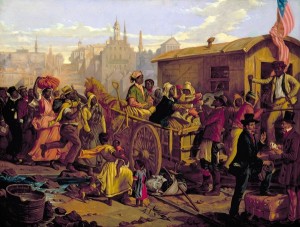The DH projects are organized based on a variety of artifacts. The categories are located towards the top of the page so the viewer can easily navigate to their desired artifact. The categories consist of archive, visualization, mapping, digital edition, and network, textual and audio analysis. Depending on the viewer’s preference in categories, they can click on the link and are shown a series of projects that fit in that specific category.
I will be focusing on the archive category in the DH projects. There are 3 articles presented that are categorized as archival material. Old Weather, Lincoln 200, and Database of Indigenous Peoples in North America all obtain original documents and artifacts that support their reasons for creating the project. The documents are primary sources that provide evidence to the specific field of study. An example of a piece of archivist material is presented in the document below. These projects give the viewer the opportunity to access archivist artifacts easily and interpret it in their own way. On the other 2 DH projects under archives, there are series of documents similar to this one that can be utilized for further analyzation and interpretation.

Another example of an archivist artifact could be a visualization rather than a document. The image posted below allows for a different perspective and can be a useful historical tool that provides insight of a specific event. Drawings and paintings can convey similar information as would a document, as both images and documents can be interpreted in various ways. 
A few advantages to creating a digital artifact from archival documents include preservation, access, and reconsidering of materials. When artifacts are digitally preserved, it ensures that copies of the documents will always be accessible. If an artifact is destroyed, the digital copy will allow researchers to still read and interpret them. A digital artifact also ensures unlimited accessibility. Specific documents could not be as easily accessible because they could be held in archives all around the world. Instead of physically visiting the archives, digital artifacts can be viewed and analyzed online. Reconsidering materials is another advantage to creating a digital artifact because it allows for different perspectives and diverse opinions. It can help make broader connections between artifacts, which could lead to a greater understanding of a particular field.
Some of the disadvantages of creating a digital artifact from archival documents include the inability to transcribe and the loss of collaboration and the community aspect. There may be certain words or ideas that could not be transcribed digitally but could be interpreted if the viewer is reading the actual document. Additionally, communication and collaboration for analyzing documents can create new ideas and opinions. However, reading digitally transcribed documents is more of an individual process which causes the viewer to lose others’ input.
When I build my own digital humanities project, I may feel that some aspects of my project are organized well. In addition, I may struggle to describe my thought process and reasoning for specific parts of my project. For example, I found that Lincoln 200 was easy to navigate but I did not understand the writer’s intent for the project.